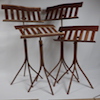Thank you Mark for the extremely kind words. I started doing boards aout 5 years ago and I do so many of them in so little time that even actually buying lumber to supplement the colors, I end up making a pretty good profit for what would usually be spent as time watching TV.... I take real pride in my boards and if I could get over the boring repeatability of it, I would do it year round. I basically set out each year to make whatever we want to spend on Christmas for ourselves, the kids, and family/friends. The last 4 years, I work just one month and it pays for all of it. Very fortunate to have repeat customers and word of mouth on these.

Originally Posted by
Mark Bolton

I dont have any input really on the sanding, we are usually running them through the sander and then hitting them with 150 or MAYBE 180... BUT....
I have to say, as much as I hate making cutting boards, and I question why I do it every time we do it, an absolutely beautiful picture like these you posted is about the only reason we do. I have tracked the profitability (even accounting for "scraps") and it all points to a loser but pictures like this (that we have taken at the end of a run) are about the only reason we keep making them.
That is a super impressive batch of boards and a beautiful photo. Im almost miserable to see it because now Im going to want to pull the cutting board scraps down from the racks and fire out a bunch.
I'm a Joe of all trades. It's a first, it'll catch on.





 Reply With Quote
Reply With Quote





